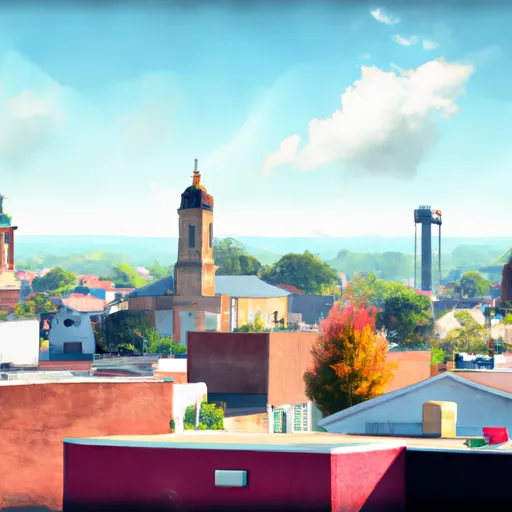-
 Snoflo Premium
Snoflo Premium
Get unlimited access to all our content
With no Ad interruptions! - Start Your Free Trial Login with existing account
Morocco
Eden Index
Climate
7.9
•
Recreation
2.9
•
Community
0.8
•
Safeguard
4.4/10

Morocco, Indiana is a small town located in the northwest part of the state. It experiences a humid continental climate, characterized by cold winters and warm summers. Winter temperatures average around 30°F (-1°C), while summer temperatures reach an average of 80°F (27°C). Precipitation is spread evenly throughout the year, with an annual average of 40 inches.
Hydrologically, Morocco lies in the Iroquois River watershed, which ultimately drains into the Wabash River. The town itself is home to several small lakes and ponds, providing opportunities for fishing, boating, and water-based activities. The surrounding area also features numerous rivers and streams, offering scenic spots for kayaking and canoeing.
Outdoor recreation enthusiasts can explore nearby parks and nature preserves. Willow Slough Fish and Wildlife Area, located just south of Morocco, provides opportunities for bird watching, hunting, and nature trails. The nearby Kankakee Sands, managed by The Nature Conservancy, offers hiking trails and a chance to observe unique prairie plant species. Overall, Morocco, Indiana provides a peaceful setting for outdoor activities and a chance to immerse oneself in nature.
What is the Eden Index?
The Snoflo Eden Index serves as a comprehensive rating system for regions, evaluating their desirability through a holistic assessment of climate health, outdoor recreation opportunities, and natural disaster risk, acknowledging the profound impact of these factors on livability and well-being.
Climate Health Indicator (CHI): 7.9
Morocco receives approximately
974mm of rain per year,
with humidity levels near 81%
and air temperatures averaging around
11°C.
Morocco has a plant hardyness factor of
5, meaning
plants and agriculture in this region thrive during a short period during spring and early summer. Most
plants will die off during the colder winter months.
By considering the ideal temperature range, reliable water supplies, clean air, and stable seasonal rain or snowpacks, the Climate Health Indicator (CHI) underscores the significance of a healthy climate as the foundation for quality living.
A healthy climate is paramount for ensuring a high quality of life and livability in a region, fostering both physical well-being and environmental harmony. This can be characterized by ideal temperatures, reliable access to water supplies, clean air, and consistent seasonal rain or snowpacks.
Weather Forecast
Streamflow Conditions
Upper Illinois
Area Rivers
Upper Illinois
Snowpack Depths
Upper Illinois
Reservoir Storage Capacity
Upper Illinois
Groundwater Levels
Recreational Opportunity Index (ROI): 2.9
The Recreational Opportunity Index (ROI) recognizes the value of outdoor recreational options, such as parks, hiking trails, camping sites, and fishing spots, while acknowledging that climate plays a pivotal role in ensuring the comfort and consistency of these experiences.
Access to outdoor recreational opportunities, encompassing activities such as parks, hiking, camping, and fishing, is crucial for overall well-being, and the climate plays a pivotal role in enabling and enhancing these experiences, ensuring that individuals can engage in nature-based activities comfortably and consistently.
Camping Areas
| Campground | Campsites | Reservations | Toilets | Showers | Elevation |
|---|---|---|---|---|---|
| Sullivan County Park | 450 | 520 ft | |||
| Lincoln Trail | None | 412 ft | |||
| Prides Creek Co Park | None | 485 ft | |||
| Montgomery Bell State Park | 80 | 618 ft | |||
| Destiny Parks Military - Fort Campbell | None | 544 ft | |||
| Ouabache Trails County Park | 45 | 446 ft | |||
| Kimmell City Park | 10 | 415 ft | |||
| Res 26 - Greene - Sullivan State Forest | 25 | 498 ft | |||
| Greene - Sullivan State Forest | None | 521 ft | |||
| Lynnville Park | 70 | 465 ft |
Nearby Ski Areas
Catastrophe Safeguard Index (CSI):
The Catastrophe Safeguard Index (CSI) recognizes that natural disaster risk, encompassing floods, fires, hurricanes, and tornadoes, can drastically affect safety and the overall appeal of an area.
The level of natural disaster risk in a region significantly affects safety and the overall livability, with climate change amplifying these risks by potentially increasing the frequency and intensity of events like floods, fires, hurricanes, and tornadoes, thereby posing substantial challenges to community resilience and well-being.
Community Resilience Indicator (CRI): 0.8
The Community Resilience Indicator (CRI) recognizes that education, healthcare, and socioeconomics are crucial to the well-being of a region. The CRI acknowledges the profound impact of these elements on residents' overall quality of life. By evaluating educational resources, healthcare accessibility, and economic inclusivity, the index captures the essential aspects that contribute to a thriving community, fostering resident satisfaction, equity, and social cohesion.

